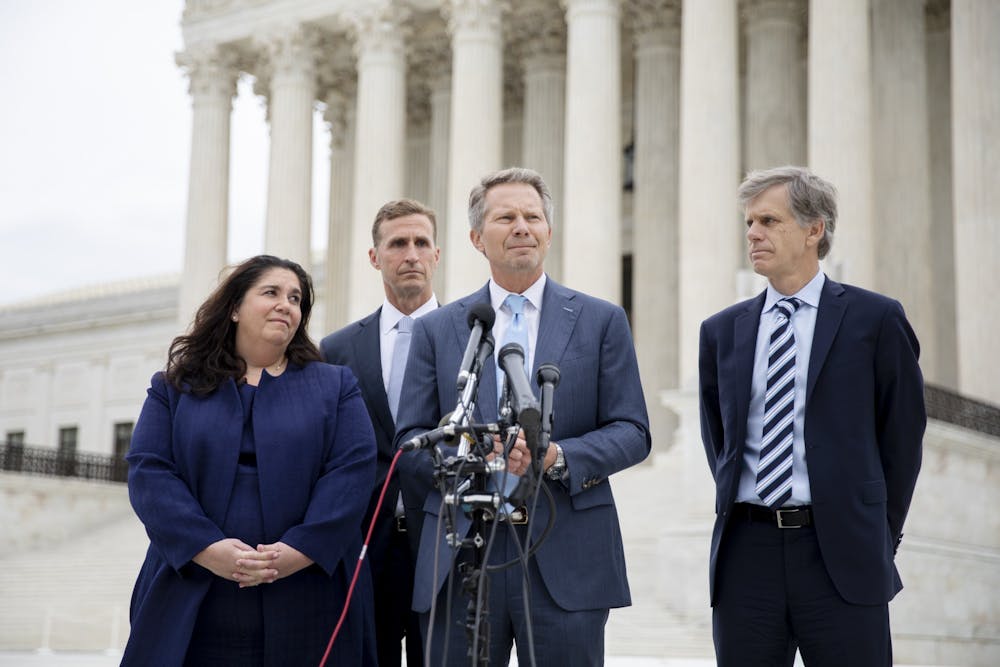“What you’re saying is it just doesn’t matter if our institutions don’t look like America,” Kagan said.
Race-neutral admissions alternatives have been found to have no effect on or to increase white admission in secondary schools, and no simulation in the record would produce the level of diversity that colleges and universities experience today, Sotomayor said.
Concluding Strawbridge’s argument, Associate Justice Ketanji Brown Jackson posed a hypothetical situation regarding admission between two students — one fifth-generation legacy student and one first-generation college student descended from slaves. Jackson expressed concerns that the University would be able to consider family background in the case of the legacy student and not the first-generation student if the court were to rule in SFFA’s favor.
Respondent Argument
North Carolina Solicitor General Ryan Park spoke for the University respondents, arguing that affirmative action, and subsequently diversity in the classroom, yields critical educational benefits.
“Diversity is our nation’s greatest strength,” Park said.
Park added that the University values diversity of all kinds, and only about 1.2 percent of the application pool is affected by the race-conscious admissions process.
Attorney David Hinojosa also presented in favor of UNC’s affirmative action policies.
After being asked by Associate Justice Clarence Thomas about the academic benefits of diversity, Hinojosa said diversity fosters innovation, broadening perspectives and reducing stereotypes on college campuses.
“These are the pipelines to leadership in our societies,” Kagan said.
Justice Thomas similarly asked Park and United States Solicitor General Elizabeth Prelogar what diversity means in the context of their arguments. Prelogar represented the United States government and its amicus curiae, or friend of the court, brief.
She said it is “critically important” to national security for universities to consider race as part of their holistic admissions processes.
To get the day's news and headlines in your inbox each morning, sign up for our email newsletters.
Students for Fair Admissions is also in a legal battle against Harvard College’s affirmative action policies. The cases were consolidated but were separated again in July after Justice Jackson recused herself from the Harvard case due to previous involvement at the university.
Dozens of other schools, including the University of Michigan, Georgetown University and Brown University have also filed amicus curiae briefs in support of UNC and Harvard's admissions processes.
Race-neutral admissions systems have yielded varying results throughout pilot states — including Arizona, California, Florida, Georgia, Michigan, Nebraska, New Hampshire, Oklahoma and Washington. This morning, counsels argued both sides of these states’ academic demographics.
Legal precedent
Under current precedent, a college or university can consider race in its admissions process so long as it is one factor in a holistic, individualized review of each applicant. Institutions of higher education cannot set numeric quotas for diversity, but can instead consider an applicant’s identity as a racial minority as an informal “plus” to the individual’s application.
The Supreme Court has a long standing-position that the use of race or ethnicity in college admissions is subject to what is known as “strict scrutiny,” or the tightest level of review required to prove discrimination by a university or other government entity. Under this standard, the issue — in this case, the constitutionality of affirmative action — must be proven to reflect a “compelling government interest” and be “narrowly tailored” to that interest.
The constitutionality of affirmative action was first confirmed in Grutter v. Bolinger (2003), a court case that acknowledged the necessity of affirmative action as a corrective system to racial inequality in higher education. Grutter, however, recommended a 25-year limit on affirmative action — a limit that would expire in six years.
The most ambiguous points of UNC’s case are in its lack of a clear, quantitative off-ramp from race-conscious admissions. Multiple counsels speaking in favor of the University this morning reaffirmed the risk that might arise by setting a “sunset” quota.
Under Grutter, UNC and other universities that consider race in admissions must often reevaluate their race-conscious policies — though in his rebuttal, Strawbridge claimed UNC has not done so adequately.
Park affirmed the University’s “vigorous review” of its admissions policies and said the University enthusiastically embraces Grutter’s durational recommendation, though not in the sense of a strict timeline.
“There is zero evidence of any student being penalized for their race or being admitted without qualifying,” Park said.
Associate Justice Brett Kavanaugh questioned Strawbridge on what qualifies as “race-neutral.” He alluded that if the Court ruled in favor of SFFA, admissions offices may try to get around direct questions of race by asking potential applicants if they are the descendants of slaves or immigrants.
Sotomayor mentioned that UNC’s history, specifically regarding Confederate relics and the recent presence of white supremacists on campus, sheds an unforgiving light on the way it deals with race in education.
“Race permeates a lot of what happens at the University,” Chief Justice John Roberts said.
After hearing arguments for nearly double its scheduled time of 90 minutes, the Court is expected to release its decision next year.
“In the end, our colorblindness — whatever society we would have that would be colorblind — comes at a high cost to UNC, the state and the nation as a whole,” Justice Sotomayor said.
@forepreston | @irawilderphoto
university@dailytarheel.com




